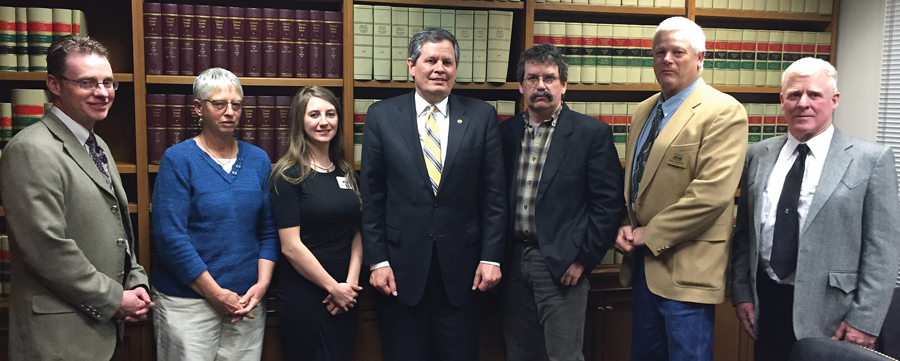Attendance on Rise for ASI’s Washington, D.C., Trip
CHASE ADAMS
ASI Senior Policy and Information Director
In the most widely attended legislative conference in the past 20 years, more than 70 sheep producers from 18 states gathered in Washington, D.C., in late March to carry forward the ASI’s priorities to their congressional representatives and hear from key federal agencies.
 On Capitol Hill, ASI members visited with their senators and representatives to lay groundwork for the upcoming Farm Bill and set out the industry’s appropriations priorities for fiscal years 2017 and 2018. Top of mind for the Farm Bill is the need for a robust risk-management program through the Wool Marketing Assistance Loan and Loan Deficiency Payment Program, the establishment of a cross-species foot-and-mouth disease vaccine bank and support for the Food and Drug Administration’s Minor Use Animal Drug Program.
On Capitol Hill, ASI members visited with their senators and representatives to lay groundwork for the upcoming Farm Bill and set out the industry’s appropriations priorities for fiscal years 2017 and 2018. Top of mind for the Farm Bill is the need for a robust risk-management program through the Wool Marketing Assistance Loan and Loan Deficiency Payment Program, the establishment of a cross-species foot-and-mouth disease vaccine bank and support for the Food and Drug Administration’s Minor Use Animal Drug Program.
While annual appropriations requests focused on fully funding Wildlife Services’ predator management program, also of importance were requiring the use of sound and accepted science when making decisions based on the mere potential of domestic and bighorn sheep conflicts and expediting alternative allotments where conflict truly is present, and continued support for the U.S. Sheep Experiment Station’s critical work in animal disease and range management. Other issues focused on ensuring Mandatory Price Reporting works to provide sheep producers transparency in the markets, continuing a fair and efficient guest-worker program and ongoing federal engagement in the scrapie eradication program.
In kicking off the annual legislative conference, members heard from ASI’s head government affairs members, Jim Richards, Vernie Hubert and ASI Executive Director Peter Orwick, to get an update on these issues and hear how to make the best use of their limited time on Capitol Hill. Following the issues brief, were a panoply of representatives from the U.S. Department of Agriculture, Food and Drug Administration and Department of Interior.
The meeting began with Wildlife Services, represented by Steve Kendrot, deputy director of wildlife operations, discussing the current scope of the program and interim policy on use of M-44s in the 12 states that employ the device for coyote management. Kendrot also noted the upcoming statistical survey and stressed the importance of honest and timely producer input when contacted to adequately access the program’s efficiency.
Jack Shere, DVM, chief veterinary officer of USDA/APHIS Veterinary Services, spoke next, focusing on issues of foreign animal disease and preparedness. While ASI members are advocating for the establishment of a foot-and-mouth disease vaccine bank and $150 million in funding in the next Farm Bill, Shere discussed what an outbreak would mean for the American livestock industry. Any outbreak is estimated to cost in the billions and, while euthanasia and disposal were once the accepted plan of response, vaccination and education have since won favor by both the producer and veterinary communities.
Currently, there are only two companies in the world prepared to produce and store the quantity and quality of vaccine the United States livestock industry would require, and the shelf life of these products is estimated at around five years. This is a major undertaking for all of animal agriculture with risk mitigation and preparedness being the best path forward at this point.
Continuing along the veterinary discussions, Meg Oeller, DVM, Ph.D., FDA Center for Veterinary Medicine Office of Minor Use and Minor Species, gave an update of her presentation from the ASI Annual Convention on enforcement of the Veterinary Feed Directive and FDA antibiotic guidance. She again highlighted flexibility in the program for minor species and urged producers to work with their veterinarian to find a regimen that works for their operation.
Oeller also touched on the current Minor Use Animal Drug Program, whose goal is to get technologies approved for use in minor species where the private market doesn’t provide adequate incentive. While this program lacks funding, FDA continues to work with land-grant universities and Paul Rogers and Cindy Wolf, DVM, of the sheep industry, to ensure producers’ needs are met.
Craig Morris, Ph.D., deputy administrator of the USDA Agricultural Marketing Service, focused on the industry’s continued efforts to provide meaningful Mandatory Price Reporting. Despite ASI’s attempts to overcome issues of confidentiality and the inclusion of price data from cooperative-structured packers, results have been slow to materialize. Morris expressed his commitment to continue to work with producers and the administration to find the path forward.
Finally, talks turned to public lands ranching led off by Joe Tague, division chief of rangeland resources of the Bureau of Land Management, who discussed current BLM permitting and issues with domestic and wild sheep conflicts. Several western affiliates engaged in a lively discussion expressing concern with the agency’s risk modeling system and preference for bighorn habitat instead of multiple-use. Sage grouse habitat restrictions and emergency grazing after fire incidents were also discussed.
Tague expressed optimism around the unveiling of BLM’s outcome-based grazing operations to set a program targeted to achieve goals for rangeland conservation and permittees.
Finally, Allen Rowley, director of forest management for the U.S. Forest Service, concluded the conversation with an outlook for permittees on USFS lands. Urging cooperation between bighorn advocates and domestic sheep ranchers, Rowley highlighted recent success stories in Colorado where a balance has been struck and alternative allotments were made available. While there has been give-and-take and the allotment holder will face additional burdens, hopefully the decision on the Snow Mesa will provide an example to build upon and improve how the agencies, working with sheep producers, can meet the mutual goal of viable wild and domestic sheep populations, as the science behind pathogen transmission and disease events continues to develop.
Until that time, producers remain concerned about the future of current allotments as they face increased pressure and a lack of cooperation from wild sheep advocates.
In the end, the land-use agencies are not mandated to manage for zero risk of disease transmission and ASI and its state affiliates remain committed to finding a mutually beneficial solution that recognizes the unique role of America’s sheep producers in support of rangeland management and economic prosperity.
Wrapping up a successful legislative conference, ASI members met with more than 100 members of Congress, representing a diverse and bi-partisan constituency.


